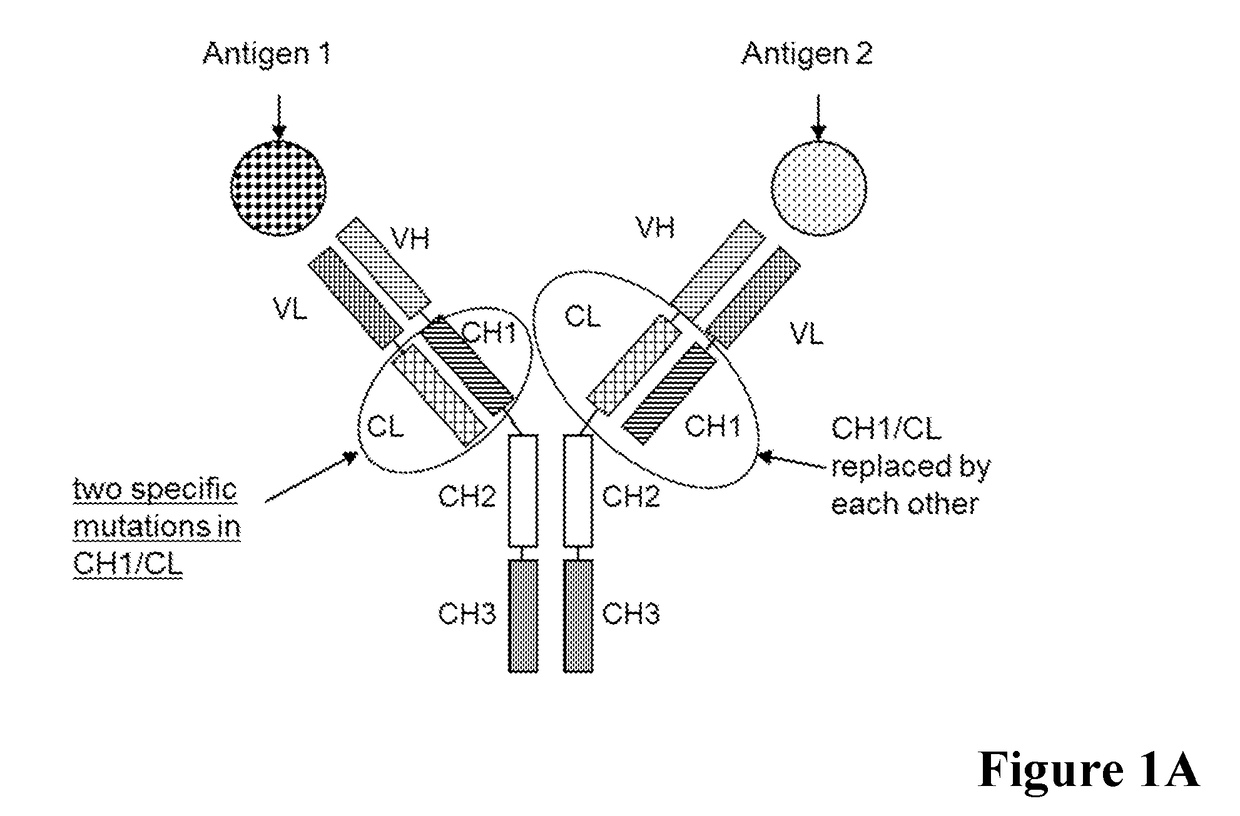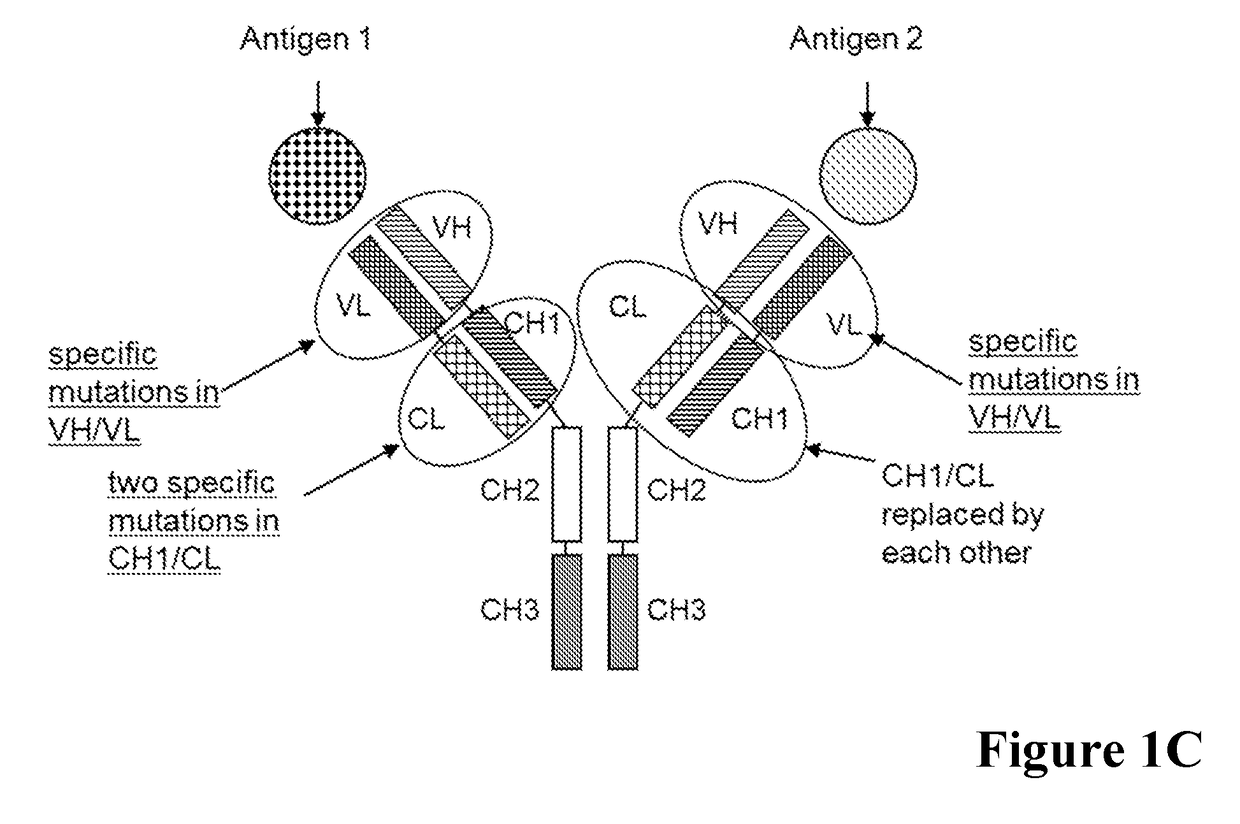Multispecific antibodies
a multi-specific antibody and antibody technology, applied in the field of new multi-specific antibodies, can solve the problems of mismatched by-products, poor antibody stability, aggregation and increased immunogenicity, and no data describing the progression towards the clinic are currently available, so as to reduce the formation of undesired side products during the production of multi-specific antibodies, thermal stability, purity and stability of the desired multi-specific antibodies can be increased.
- Summary
- Abstract
- Description
- Claims
- Application Information
AI Technical Summary
Benefits of technology
Problems solved by technology
Method used
Image
Examples
example 1a
Production and Expression of Bivalent, Bispecific Antibodies which Bind to Angiopoietin-2 (ANG2) and Vascular Endothelial Growth Factor (VEGF), with CL-CH1 Domain Exchange (CrossMAbCH1 / CL) in One Binding Arm and with One or Two Charged Amino Acid Substitutions in the CH1 / CL Interface
[0514]In a first example bispecific antibodies which bind to human Angiopoietin-2 (ANG2) and human Vascular endothelial growth factor (VEGF) were generated as described in the general methods section by classical molecular biology techniques and expressed transiently in HEK293 cells as described above.
[0515]A general scheme of these respective bispecific antibodies is given in FIG. 1. For comparative analyses the wild type (wt) CL-CH1 domain exchange antibodies without charged amino acid substitutions in the CH1 / CL interface were prepared. The bispecific antibodies were expressed using expression plasmids containing the nucleic acids encoding the amino acid sequences as shown in Table 1.
TABLE 1Amino acid...
example 1b
Protein A Purification of Bivalent, Bispecific Antibodies which Bind to ANG2 and VEGF, with CH1-CL Domain Exchange (CrossMAbCHl-CL) in One Binding Arm and Charge Pair Substitutions in the Fab Arm and / or one Additional Charged Amino Acid Substitutions in the CH1 / CL Interface
[0517]The bispecific antibodies expressed above in example 1A were purified from the supernatant by a combination of Protein A affinity chromatography and size exclusion chromatography. All bispecific antibodies can be produced in good yields and are stable. The obtained products were characterized for identity by mass spectrometry and analytical properties such as purity by CE-SDS, monomer content and stability.
[0518]The expected primary structures were analyzed by electrospray ionization mass spectrometry (ESI-MS) of the deglycosylated intact CrossMAbs and deglycosylated / plasmin digested or alternatively deglycosylated / limited LysC digested CrossMAbs as described in the general methods section.
[0519]Results are ...
example 2
SEC Purification, Analytical Characterization and Thermal Stability of CrossMAbsCH1-CL with One Additional Pair of Charges in the CH1 / CL Interface
[0521]The bispecific antibodies Ang2VEGF-0454 (control), -0455, -0456, -0457, -0458, -0459 and -0460 were further purified by size exclusion chromatography. All bispecific antibodies can be produced in good yields and are stable. The obtained products were characterized for identity by mass spectrometry and analytical properties such as purity by CE-SDS, monomer content and thermal stability.
[0522]The expected primary structures were analyzed by electrospray ionization mass spectrometry (ESI-MS) of the deglycosylated intact CrossMAbs and deglycosylated / plasmin digested or alternatively deglycosylated / limited LysC digested CrossMAbs as described in the general methods section.
TABLE 3Purity and aggregation onset temperature of CrossMAbsCH1-CL with one additional pair of charges. Increase of Aggregation temperature by charged amino acids subs...
PUM
| Property | Measurement | Unit |
|---|---|---|
| pH | aaaaa | aaaaa |
| pH | aaaaa | aaaaa |
| pH | aaaaa | aaaaa |
Abstract
Description
Claims
Application Information
 Login to View More
Login to View More - R&D
- Intellectual Property
- Life Sciences
- Materials
- Tech Scout
- Unparalleled Data Quality
- Higher Quality Content
- 60% Fewer Hallucinations
Browse by: Latest US Patents, China's latest patents, Technical Efficacy Thesaurus, Application Domain, Technology Topic, Popular Technical Reports.
© 2025 PatSnap. All rights reserved.Legal|Privacy policy|Modern Slavery Act Transparency Statement|Sitemap|About US| Contact US: help@patsnap.com



